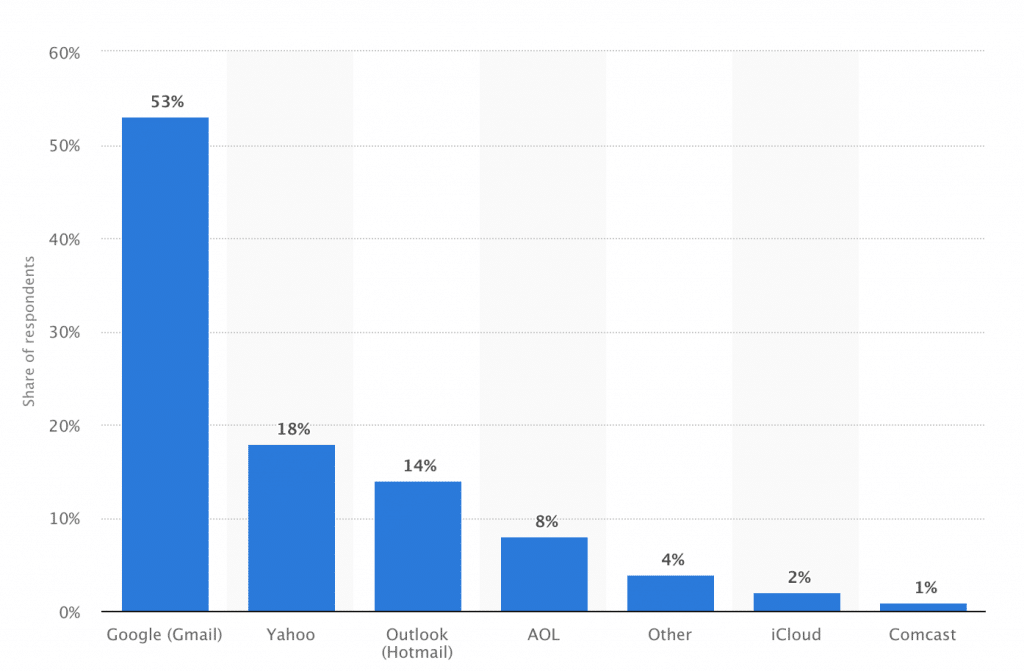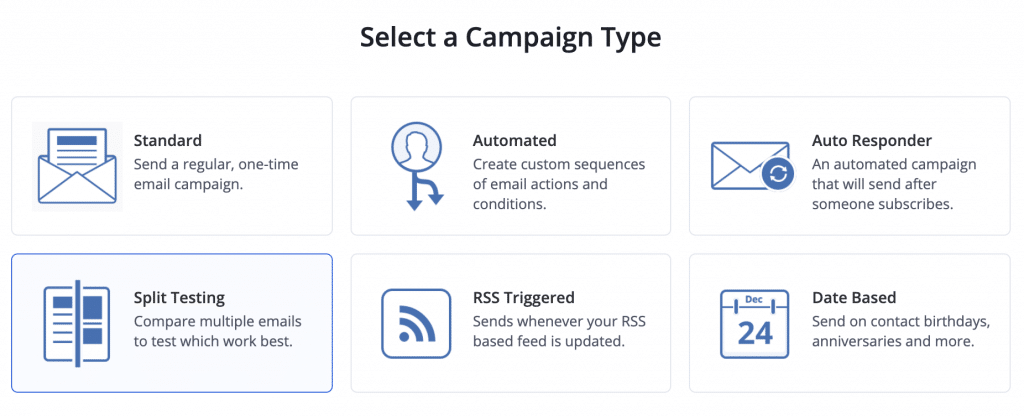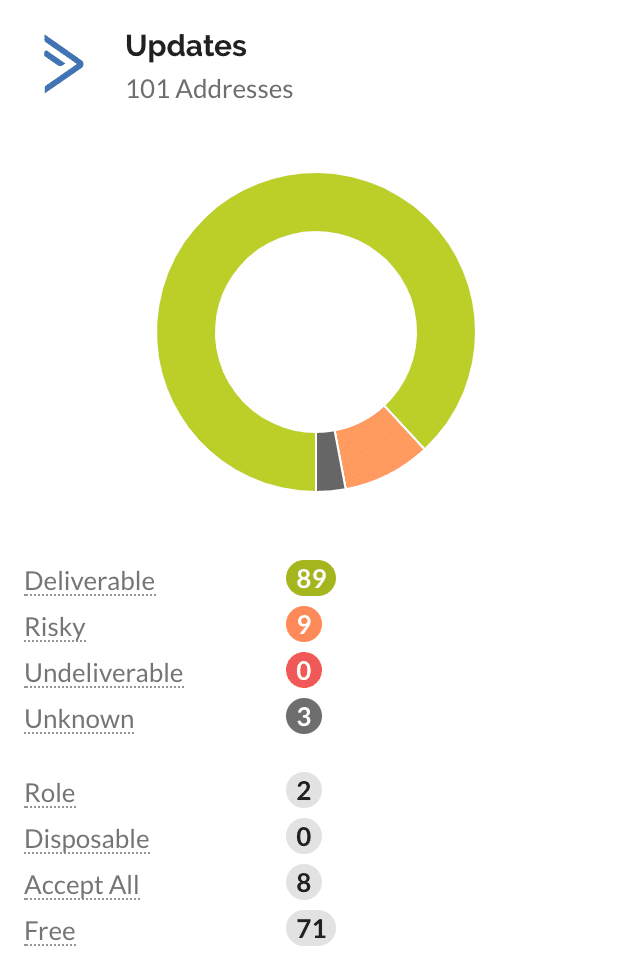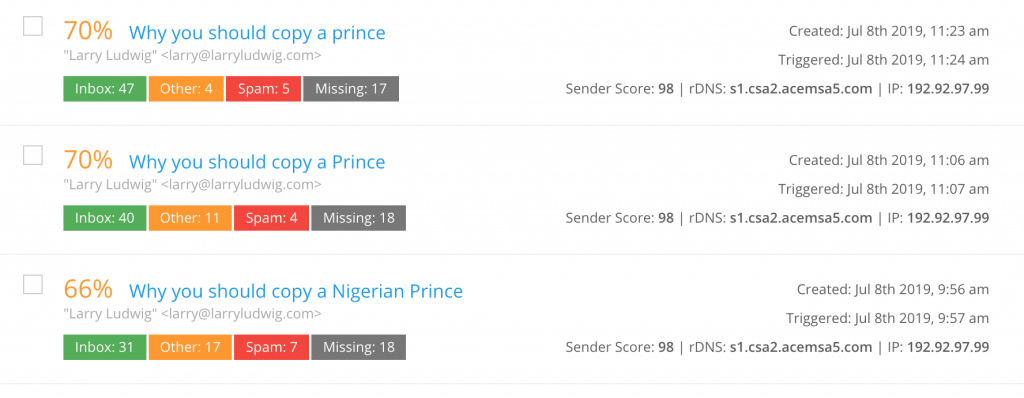According to Campaign Monitor, the average email newsletter open rate is just 18%. I don’t know about you, but I think that statistic is pathetic.
It means, on average, 82% of your email subscribers aren’t opening your emails!
If you have a list of 10,000 subscribers, it means only 1,800 are getting your message.
By the time you finish reading this, you should be able to more than double your open rate to 40%. Don’t believe me? Keep on reading.
You’ve spent time (and in many cases, money) to acquire these subscribers, yet they aren’t getting your message. What you should do? Dump email and use only social media?
No way!
Facebook can be effective, but you’re at the mercy of the platform. To get any reach, you have to “pay to play.”
Plus, across Facebook, YouTube, Twitter, and Instagram, accounts are getting demonetized or outright banned. Sometimes there’s no specific explanation or recourse.
What about Google SEO?
It’s becoming increasingly evident Google wants you to pay to appear in search results. Organic search results are constantly being pushed further down the page by paid ads.
Businesses that rely on just one channel as a source of traffic are going out of business overnight.
And it’s only going to get worse!
Email is still a very effective medium for getting your message across. Although there’s some variation that depends on demographics, most individuals use email in some capacity.
Email marketing is here to stay.
Gmail is Still on Top
I have to laugh at other internet marketing gurus.
I hear them make statements like:
- “The money is in the list”
- “Control your destiny by having a mailing list”
- “Don’t rely on Google and Facebook controlling your business”
I agree, but I’ll let you in on a little secret. Who do you think controls most email inboxes?
The answer is Google, which controls 53% of the U.S. email market. Yahoo is a distant second at only 18%, and Microsoft comes in third.

With Email, Google is still your gatekeeper.
How to Increase Your Open Email Rates
I’ve used and tested most of the mailing list providers out there — AWeber, MailChimp, Drip, and Keap…
After a long, hard look, I now personally use ActiveCampaign.
ActiveCampaign has proven to have the best delivery rates in the industry year after year. With all of the features offered, the company can serve both product and service-based businesses very well.
Unfortunately, I can’t give examples for every mailing list provider on the market. My examples will use ActiveCampaign. However, you should be able to replicate what I discuss with most other providers.
With that out of the way, let’s discuss how to improve the open rates and deliverability of your emails.
Larry's Take
| Platform | Cloud, WordPress |
|---|---|
| Price | $15 - $1,306+ per month |
| Annual Discount | Yes |
| Promotion | Get Started Free |
Test Your Email Subject Line

The subject line is what gets people to open your email. It has the biggest effect on your open rate, and coming up with a good one is the first step to a successful email campaign.
The subject line should be related to the email. But that doesn’t mean it should be dry and boring.
As with SEO or paid ads, you need some headline hook to get your readers to open your emails.
Mind you, I’m not into “link bait” headlines all that much. However, I do recommend creating an email subject line that will entice your audience to read the article.
One idea is to subscribe to various email newsletters in your vertical and other niches. Ask yourself, “What gets me to open an email?”
It’s been said real artists steal. See what your competition is doing and improve upon it. Don’t assume your rivals have all the answers, but at least it’s a start.
There are many articles and books on this topic. Here are some that give good guidelines and examples you can steal… ahem… use.
- The 9 Best Email Subject Line Styles to Increase Your Open Rates
- 164 Best Email Subject Lines to Boost Your Email Open Rates
- No products found. by Ray Edwards
- No products found. by David Garfinkel
Once your list has more than 1,000 subscribers, start split-testing your subject lines.
With ActiveCampaign, this is easy.
When creating a new email campaign, select the “Split Testing” option.

Even if you don’t have a large-enough list yet, note the email campaigns you send out and their respective open rates. Some email subjects will yield more opens than others. Experiment to see which subject lines seem to get more emails opened.
Use the Same Address and Name for Every Email
I recommend using one email address for all emails. Branding is all about consistency. As you send out emails, people expect to see a specific sender’s email address.
What exactly you use depends on your brand. If it’s a personal brand, it makes sense to use your name. If it’s a company with multiple contributors, use the brand name.
For my investing website, we used “Investor Junkie <[email protected]>” for every email. Because it was so easily recognizable in an inbox, we did this even if an email was written and signed by a specific individual. We were creating a brand around Investor Junkie, not the individual writers.
This site, it’s all about me, so I’m using my name and personal email address. It’s me and only me speaking, so it’s natural the message should always come from me.
Lastly, by using the same email addresses, you’re building up a reputation with the email providers. The more interactions with your emails (opens and links clicked) and the fewer spam or “unsubscribe” reports, the better.
It should be noted that you should also use a real email address that people can reply to. Set up an account so you can get these emails.
An email reputation is important, so make sure your messages aren’t getting sent to the spam folder or Google’s dreaded Promotions tab.
A Good Thank-You Webpage
What?!
Yes, your email thank-you webpage can help increase open email rates.
This is a wasted opportunity for most sites. Most thank-you pages say, “Thank you for subscribing to our newsletter,” and are done with it.
Look at it this way. The visitor trusted you enough to take action and enter their email address. You have an engaged subscriber; use this to your advantage, especially while they’re a warm lead.
Use the thank-you webpage to set expectations. You can tell them the following:
- How often you’ll send out emails
- How to prevent emails from getting marked as spam
- Any special promotion or offer for signing up
- A low-end product offering
- A surprise bonus
A Strong Welcome Email
Your welcome email is a critical inflection point in the relationship. The thank-you webpage is the next step in establishing your brand.
It’s also not uncommon to get 40-60% and even 70%-plus open rates with this email. Use this email wisely and establish a good rapport with your readers immediately.
You can even repeat the information I suggested for the thank-you page.
However, even ActiveCampaign isn’t perfect. With the shared plans, you can still have poor delivery. If you have a list of 100,000-plus subscribers, getting a dedicated IP address would make the most sense. I’m not sure of the other providers, but I do know ActiveCampaign offers this option with the Enterprise-level plan.
Consistent Time and Day of the Week
People like consistency. They get up at the same time each day, order the same lunch, and watch the same TV shows.
The same applies to your email routine.
If you’re sending out a weekly newsletter, it’s not uncommon for people to expect it. I’ve had friends miss a week and get emails from their audience asking if everything is OK with them. As if they’d died or something…
What’s the best time and day of the week to send out an email? That depends.
For most industries, Monday through Thursday, 10 a.m. to noon and 3 to 9 p.m., are the peak times.
If unsure, send out your email newsletter on Thursday at 3:30 p.m. and call it a day. Adjust accordingly as you look at your open rates. Your industry and even your audience can vary.
As always, test, test, test! Let your users tell you the answers via reporting. Always give your first best guess and test with different days and times.
So far, I’ve found my LarryLudwig.com audience responds better to emails sent out in the afternoon to very late evening. However, my Investor Junkie’s audience liked getting emails during work hours. (Get back to work!)
It was obvious most of my Investor Junkie audience was daydreaming of improving their finances while at work. But most of my current audience already owns a business and is checking when they have some free time.
List Hygiene
Most mail service providers can detect automatic bounces and email rejections. So in most cases, you shouldn’t have to worry about those list issues.
Instead, I want to discuss how some email addresses are better than others.
An email sent to [email protected] is more likely to be opened than one sent to [email protected].
If you are in a B2B industry, collect a business email address, rather than one from a free email service.
How do you get such emails? Ask, of course!
Here’s a sample email form.

How you ask can be as simple as requesting their “best” email address in your website copy. Or it can be as drastic as preventing the submission of any free email addresses. I don’t recommend the latter for most situations. Consumer-based businesses obviously can’t be that strident.
However, you should realize most individuals use free email services, either because that’s all they use for email or because they have a burner email address for mailing lists like yours.
I prefer to make each micro-commitment as painless as possible for the visitor. This means not using things like a CAPTCHA on a sign-up form. In my opinion, these little tests are too clunky.
Instead, you can be more subtle with your list hygiene and control it on the backend.
There are services that can score each email address on your list. I recommend Kickbox for email verification.
Email verification can be either batched or done in real-time. I prefer real-time since I can adjust the email automations. In my case, every email sign-up to my mailing list gets checked and scored by Kickbox.
You can score your readers based on things like:
- If it’s a free email account
- If the email account is disposable
- If it’s a catch-all email address (meaning it accepts emails from multiple addresses)
- If it’s a “role” email account (i.e., postmaster@, info@, etc. )
Not only can these scores affect the open email rate, but they can give you clues as to how serious the prospect is.
I despise disposable email accounts and prefer not to let them subscribe to my mailing lists. For my purposes, those subscribers get sent to their own segment.

Take Kickbox’s quality indicators as suggestions. Kickbox scored what I knew were good email addresses as “Risky.” That’s not to say a service like Kickbox is useless.
You can use email verification to segment your audience. This can lead subscribers down a specific path.
The other option, instead of doing it in real-time, is checking your subscribers via a batched method. In my opinion, a service like Kickbox isn’t as effective when batched. With batched checks, you must review your list periodically and validate your subscribers.
If you are using single opt-in sign-ups, you can pair this with list hygiene and score suspect emails as they come in. You can sandbox them (meaning you put them into “time out”) until the subscriber goes through some test – for example, confirms their email address by clicking a link.
Segment Your Audience
As you build up your email list, you will naturally have different audiences. Each audience’s needs can be different depending on how they signed up.
Sending a mass group email to all your readers isn’t suggested. It leads to lower open rates, more “unsubscribes,” and, overall, more irate readers.
For example, if you’re a mommy blogger and you discuss topics from pregnancy to raising an infant, the needs of your readers will be varied. A woman who has an infant isn’t going to care about pregnancy tips.
If you segment your audience and send only the information they care about, the open rates will naturally be much higher.
How do you segment? By tagging your readers at email sign-up. Here are some of the ways you can segment your audience:
- UTM parameters
- The webpage they signed up from
- The category of the post
- The form/offer they signed up with
- A link clicked in an email after they subscribed
- A specific email that’s opened after they subscribed
With ActiveCampaign, segmenting is easy. You can do it either via separate mailing lists or by tagging subscribers. Tags allow a subscriber to have multiple attributes you define.
What you use to segment your audience depends on your business.
Re-engage or Remove Inactive Subscribers
If a subscriber hasn’t opened or clicked on an email after a specified period of time, they’ve become inactive. Your warm lead just became cold again.
You need to re-engage these subscribers.
ActiveCampaign has prebuilt a three-part automation that begins after a specified period of inactivity. You can see the templates here and here and the email sequence here.
If you’ve tried to re-engage your inactive subscribers, but they’ve “ghosted” you – what do you do?
I’m sad to say it, but you remove them.
For many people, life tends to get in the way. Perhaps they aren’t interested in your services after all. Perhaps they changed their email address. Perhaps they died – it’s a morbid fact that on a large-enough mailing list, this happens.
You need to cut your losses and move on.
What’s the ideal time to remove these people? I would recommend no shorter than six months, and no longer than one year. If, after one year, they haven’t opened a single email or clicked on a link, there’s no point in keeping that subscriber. They’re just wasted space.
Look — don’t get hung up on removing subscribers. If anything, rejoice!
It means, for whatever reason, they weren’t a fit for your business. Since you pay per subscriber, it means savings for you.
Let’s use ActiveCampaign as an example. You can have 10,000 subscribers on their Plus Plan. You’ll save 25 cents per year per email address. While that doesn’t seem like a lot, it can add up quickly if you’ve got thousands of deadbeat subscribers.
By removing inactive subscribers, you automatically increase your open rate. I know that sounds like cheating. But with direct marketing, quality – not quantity — counts. I’d rather have an audience of 1,000 with an open rate of 50% than an email list of 5,000 with an open rate of just 10%.
Both email lists have an active audience of 500, which counts.
Remarket Inactive Subscribers
This is an advanced technique you could test with your niche.
Upload your email list of inactive subscribers to Facebook and/or Google Ads. Offer a special promotion to entice them back.
If they’re no longer checking their email, this method may catch them. You can also offer other means of keeping in touch (i.e., social media, SMS, push notifications, etc.) to keep them engaged.
You can do this either simultaneously as you re-engage your subscribers or after you’ve unsubscribed them from your mailing list.
Of course, this is a long shot that really depends on your business. If you believe a subscriber still has potential (maybe they ordered a product once), try this method.
Since you’re targeting a very specific and small audience, remarketing is often very cheap. It’s worth testing out. Let me know your results in the comment section below.
The Double Opt-In
First, let me state I’m not a fan of the double opt in.
“Double opt-in” means that, after a visitor submits their email address, they must confirm they want your newsletter by clicking on a link in your email. So your subscription is a two-step process.
While it’s the “gold standard” for email opt-ins, I find that some audiences don’t click on that email. Either they’re being lazy, they forget, or they’re afraid your link will blow up their computer.
Whatever the reason, they don’t confirm their subscription, and you now have someone on your list whom you cannot email. This currently does NOT mean you can’t use that email address for other purposes. These email addresses can be used for remarketing on Facebook and Google.
So as with inactive subscriptions, you could offer this audience a special promotion and get them to purchase something. Either way, don’t let this audience go completely to waste.
My testing found that double opt-in vs. single opt-in yielded the same open rates. I have friends who’ve gotten similar results. So I’ve kept my sign-up process as a single opt-in since it’s made everything easier. Your mileage may vary, and you should test it yourself.
On the other hand, with a double opt-in, you do know your subscribers have engaged at least once by confirming their subscription to your mailing list.
Tell Subscribers How to Improve Email Delivery
In your welcome email, tell the subscribers how to ensure better email delivery. Tell them in advance that some emails might go to the spam folder and how to fix this.
Add Email to Address Book
If your subscribers add your email address to their contact lists, some mailing services will note this change. This decreases the chances of your email being marked as spam.
It’s an easy task, but unfortunately, few subscribers will do this.
To make this process somewhat easier, create a vCard. A vCard is a format by which you can pass someone your contact information. You can also add your phone number so they can contact you with customer service issues as well.
Fortunately, there are free tools online that can help you create your own vCard. You can also check out my vCard as an example.
Move Emails From the Secondary Tab to the Inbox

This is with Google’s Gmail service.
Test Emails Before Sending
Use Mail Tester

Mail Tester is a free tool that allows you to test emails before you send them out.
From my experience, Mail Tester is really good for testing the basics of your email setup. The spam checking is just OK.
Mail Tester uses the popular (and free) spam-filtering system SpamAssassin, which is used only by small hosting providers. It won’t help with Gmail, Yahoo, or Microsoft.
If your SPF or DKIM is invalid, these must be fixed. Otherwise, it hurts the chance of your email getting delivered.
If you are using an ESP, it’s assumed your subscribers have set up their mail servers correctly when it comes to rDNS, SPF, and the like, but it doesn’t hurt to check.
Use GlockApps

GlockApps is a commercial service that tests the delivery of all the popular email services such as Gmail, Outlook, Yahoo, and AOL.
It has a list of about 80 email accounts that you send an email campaign through. GlockApps then determines if the email was delivered or if it went to the spam folder or Gmail tabs. GlockApps gives recommendations on how to improve deliverability as well.
It’s highly recommended you test your emails using this service. GlockApps is worth its weight in gold.
Below is an example of an email campaign in which I increased the delivery rate. I removed what the system considered some spammy content and adjusted my format slightly. I increased the inbox delivery and decreased the number of emails going to Gmail’s Promotions tab. Obviously, there’s some work I need to do to figure out why some emails went undelivered.

Make Sure Your Domain Name Is Set up Correctly
SPF, DKIM, and DMARC… oh my!
These acronyms are the tools to validate the sender of an email. When email was first created, no one thought about someone spoofing an email (aka spam). Spam email exists primarily because of the weakness in the email protocol.
SPF, DKIM, and DMARC are an attempt to fix this flaw and prevent spam. Unfortunately, they can also prevent your email from getting delivered.
The problem is your emails must also adhere to these protocols. Otherwise, you risk having your email delivered to your spam inbox.
As I mentioned previously, Mail Tester can tell you if your SPF, DKIM, and DMARC are set up properly. If not, you need to fix them.
I’m not going to cover how to fix them in this article. Make sure you realize that if these protocols are missing or incorrectly set up, you must fix them.
If they are set up properly, that’s one less roadblock in getting your emails delivered.
Switch Email Service Providers
As I mentioned initially, not all email service providers (ESPs) are created equal.
When you join a mail service provider, think of it like renting an apartment in a multi-unit complex. All it takes is one neighbor who has loud late-night parties to ruin it for the others. The same applies to ESPs.
If the ESP doesn’t police its clients when they send out spam or questionable content, your delivery rate is affected.
Of all the ESPs, ActiveCampaign has the best delivery rates. That’s one of the reasons why I use this service.
However, even ActiveCampaign isn’t perfect. With the shared plans, you can still have poor delivery. If you have a list of 100,000-plus subscribers, getting a dedicated IP address would make the most sense. I’m not sure of the other providers, but I do know ActiveCampaign offers this option with the Enterprise-level plan.





